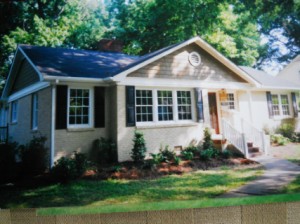
 I am always on the hunt for articles and additional information to provide our readers that they may find helpful. This article from Money Magazine jumped off the page and I sure hope you all find it both helpful and informative.
I am always on the hunt for articles and additional information to provide our readers that they may find helpful. This article from Money Magazine jumped off the page and I sure hope you all find it both helpful and informative.
(MONEY Magazine) — Lean times call for budgetary triage. But while you should clearly opt for orthodontics before Disneyland, the choice is tougher when it comes to home maintenance.
Should you get a paint job or a new furnace? “There’s no homeowner’s manual that tells you when to do what,” says Naperville, Ill., home inspector and structural engineer Mark Waldman
Emergencies aside, the project that could cause the most damage and expense if left unfixed is the priority. Below, the order in which to tackle your biggest repair needs.
1. Electrical system
Wiring problems claim the No. 1 spot for good reason: They can lead to fires and electrocution. “That trumps everything,” says Waldman.
Danger signs: Circuit breakers that trip frequently, lights that dim when you turn on the vacuum or outlets that are loose, hot, or accept only two-prong plugs.
How to check: Spend $300 to $500 for a licensed electrician to open up your main panel to look for trouble and to tighten any loose connections. He’ll also spot-check switches, outlets and light fixtures to ensure that the wiring is in safe working order
Replacement cost: $4,000 to $10,000 to rewire the house.
Prolong its life: Flip every circuit breaker off and on again once a year to prevent corrosion. Add new circuits ($100 to $500 each) to take the heaviest electrical loads, like window air conditioners, off the old wires.
2. Basement
Structural problems downstairs mean shifting and cracking upstairs — at the very least — so there’s little point in doing other repairs until you’ve fixed the building’s foundation.
Danger signs: Bowed or split beams, rotted posts, piles of sawdust (evidence of wood-boring insects), tiny mud trails (indications of termites), or large cracks in the masonry foundation — especially if the cracks are horizontal, which tends to indicate a bigger problem.
How to check: A contractor will usually take a look free of charge. If he recommends significant repairs, hire a home inspection engineer (find one at nabie.org) to investigate ($350 to $500).
Replacement cost: Major foundation work can cost $3,500 to $8,000; new posts or beams could run $1,200 to $2,500.
Prolong its life: Water is the cause of cracked concrete, rotten timbers and wood-eating pests. So keep your basement dry by making sure the landscape slopes away from the house and maintaining the next two items on the list: the roof and gutters.
3. Roof
Water leaking into your home from above can lead to a host of pricey problems: rot, insects, electrical shorts and mold.
Danger signs: Dampness or stains on ceilings; curling, missing, or broken shingles; smooth spots where the granules have worn away; green algae growth.
How to check: Have a roofer inspect your home. This is typically free, but the pro, of course, is looking for business. So check the company’s reputation at angieslist.com ($5 a month).
Replacement cost: $5,000 to $15,000
Prolong its life: Prune tree limbs so they’re at least 10 feet from the roof to keep squirrels away and to let moisture evaporate quickly after storms. If shingles blow off, replace them immediately, and repair small leaks promptly.
4. Gutters
Your gutters are just as important as the roof. The only reason they’re lower on this list is that if you replace gutters first, they’re likely to get damaged when you reroof later. So if you need a roof too, it’s better to wait — or do both projects at the same time.
Danger signs: Dented or disconnected gutters, pooled water around your home’s foundation, or basement flooding near the downspouts.
How to check: Head outside during a rainstorm and watch the gutters in action, says Caitlin Corkins, stewardship manager for Historic New England, which maintains dozens of historic properties. “The best time to see clogs and overflows is when the system is working,” she says.
Replacement cost: $1,500 to $3,000
Prolong its life: Hire a gutter company to clean, check, and repair your gutters ($100 to $200) at least once a year — two or three times if you’re in a wooded area. And have someone clear the eaves of deep snow to prevent icing, which can split open gutters or rip them right off the house.
5. Exterior walls
“People think paint is just a decorative element, so they let it go,” says Robert Niemeyer, a Winston-Salem, N.C., handyman, contractor, and electrician. But without a weather-tight seal, water can infiltrate the siding, causing rot.
and attracting wood-damaging insects. Still, leaks from a vertical surface generally aren’t as quick or lethal as ones from a roof and gutter.
Danger signs: Paint that’s peeling, cracking or blistering
Replacement cost: $4,000 to $10,000; make sure the painters replace loose putty around the window glass and caulking gaps around molding
Prolong its life: Hire a pro to do touchups every year. Trim foliage so it’s at least a foot from the house, and kill any mildew growth with a bleach-and-water solution.
6. Aging equipment
An old heating or cooling system is costly to operate — and the risk of a breakdown increases with age. But as long as your old furnace, boiler, or AC is operating safely, there’s no rush to upgrade.
Danger signs: The system cycles on and off frequently to hold your thermostat setting; you spot corrosion on the vent pipe; the natural-gas flames are yellow or orange instead of pure blue.
How to check: Get a repair estimate: if it’s more than a third of the replacement cost, spring for a new machine, says Indianapolis plumber Larry Howald.
Replacement cost: Typically $2,000 to $4,000 for a furnace (forced air); $4,000 to $8,000 for a boiler (hot water); $1,000 to $3,000 for a water heater; $6,000 to $10,000 for an air conditioner.
Prolong its life: Have your systems cleaned and tuned annually, including flushing the water heater to remove sludge, replacing all filters and lubricating any pumps
Replacement cost: Typically $2,000 to $4,000 for a furnace (forced air); $4,000 to $8,000 for a boiler (hot water); $1,000 to $3,000 for a water heater; $6,000 to $10,000 for an air conditioner.
Prolong its life: Have your systems cleaned and tuned annually, including flushing the water heater to remove sludge, replacing all filters and lubricating any pumps.
Hope you found this informative. Best! Steven C

